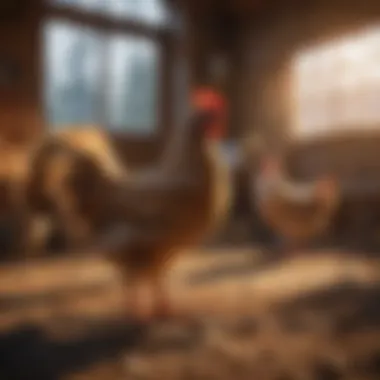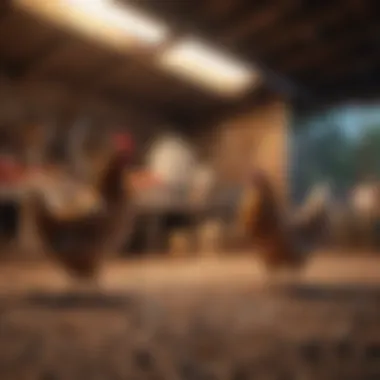Optimal Lighting Solutions for Your Chicken Coop


Intro
Maintaining a well-lit chicken coop is vital for both poultry productivity and the overall health of the birds. Proper lighting affects egg production, flock behavior, and even their immune response. In this article, we will explore the best lighting options suitable for chicken coops. We will examine several factors that can influence your choice, including energy efficiency, color temperature, and light intensity. Moreover, we will look at various implementations of lighting systems, along with their associated benefits. This comprehensive guide will provide useful insights for chicken owners looking for effective ways to enhance the living conditions of their flock.
Importance of Lighting in Chicken Coops
Light plays a crucial role in the lives of chickens. Chickens naturally respond to the length of daylight, which directly influences their reproductive cycles. In periods of shorter days, their egg production may decrease. Supplemental lighting can help overcome this seasonal drop in egg production. Beyond reproduction, good lighting contributes to the overall well-being of chickens. It can help reduce stress and improve their behavior. To ensure that your poultry remain healthy, integrating the right type of lighting in the coop becomes paramount.
Types of Lights for Chicken Coops
Selecting the correct type of light is an essential task for chicken coop owners. From incandescent bulbs to LED options, each type has its unique benefits and drawbacks. Here is a breakdown of some popular lighting choices:
- Incandescent Bulbs: These bulbs provide a warm light but are not energy efficient. They generate more heat, which may not be suitable for coops in warmer climates.
- Fluorescent Lights: More energy-efficient than incandescent options, fluorescent lights provide good illumination and can cover wider spaces effectively.
- LED Bulbs: LED lights are highly efficient and have a long life span. They are available in various color temperatures, allowing for customization based on specific needs.
- Solar Lights: For more eco-friendly options, solar lights harness sunlight during the day and provide illumination at night. They may be less consistent but can reduce electricity costs.
When choosing lights, considering the needs of your chickens and your local environment is essential.
Energy Efficiency
When planning your coop's lighting, energy efficiency is a significant factor to consider. Using energy-efficient lighting helps reduce electricity costs and minimizes your carbon footprint. LED lights are the most recommended due to their longevity and power-saving capabilities. Although the initial cost is higher, the long-term benefits often outweigh the upfront expenses.
"Incorporating energy-efficient technologies can dramatically reduce the operational costs of maintaining a chicken coop."
Color Temperature and Light Intensity
The light's color temperature impacts the chickens' behavior and productivity. Warmer lights, around 2700K to 3000K, emulate the natural light conditions of sunrise and sunset, which can provide comfort. Cooler blue tones are often seen as stimulating but can lead to stress if used in excess.
Light intensity also plays a role. Bright lighting can increase activity, but excessive brightness may lead to stress. It’s essential to find a balance that encourages healthy behaviors without overwhelming the flock.
Epilogue
Choosing the right lighting for your chicken coop is more than merely illuminating the space. It involves understanding the needs of your flock, selecting energy-efficient options, and creating an environment that promotes health and productivity. Different types of lights present unique advantages, and evaluating available choices can lead to better outcomes for both you and your chickens.
Prelims to Chicken Coop Lighting
Lighting plays a crucial role in the management and well-being of poultry. Understanding the effective use of light is essential for optimizing both the health and productivity of chickens. This context is particularly important when selecting the best lights for a chicken coop, as lighting can significantly influence various aspects of chicken behavior and egg production.
Proper light management within the coop is not merely about illuminating the space; it is about creating an environment that encourages natural behaviors in chickens. The specifics can range from influencing sleep cycles to enhancing egg-laying performance. This introduction aims to outline the significance of thoughtful lighting solutions, guiding poultry keepers to make informed decisions. By picking the right lighting systems based on accurate data, chicken owners can enhance flock health and improve overall egg production.
*
Understanding the Role of Light in Poultry
Chickens are highly responsive to light, and this responsiveness affects their daily rhythms. Light impacts the hormones that regulate growth, reproduction, and health in poultry. The management of light in a chicken coop can affect their biological clock, sometimes known as circadian rhythms. This means that the quality and quantity of light can either promote or hinder optimal growth and egg-laying potential.
When chickens perceive lighter conditions, they tend to become more active; conversely, darkness signals them to rest. Thus, understanding how light affects poultry can provide essential insights into nurturing a productive and healthy flock.
Benefits of Proper Lighting
Proper lightinghas several advantages that can positively influence chicken coops:
- Enhanced Egg Production: Supplemental lighting can prolong daylight hours, encouraging hens to lay more eggs, especially during the shorter days of winter.
- Improved Health: A well-lit environment can help prevent issues like pecking and stress, ensuring chickens remain calm and healthy.
- Behavioral Stability: Chickens generally thrive in consistent lighting conditions. Sudden changes can lead to stress, which might affect their welfare.
- Efficient Feed Conversion: Proper lighting can improve feed efficiency, resulting in better weight gain and overall health.
*


Types of Lighting for Chicken Coops
Choosing the right lighting for your chicken coop is not just a matter of aesthetics. The type of lights you install plays a crucial role in the health and productivity of your flock. Proper lighting can influence egg production, overall behavior, and even the well-being of the chickens. Each type of lighting comes with distinct characteristics, advantages, and considerations that can affect your decision.
Incandescent Bulbs
Incandescent bulbs have been a traditional choice in many poultry settings. They emit a warm light that chickens seem to prefer. The soft glow can create a calming environment. However, they are not the most energy efficient. Incandescent bulbs convert most of the electricity into heat rather than light. This means higher energy costs in the long run. They also have a shorter lifespan compared to other options. Generally, they last about 1,000 hours.
It is important to note that incandescent bulbs may not provide the optimal light spectrum for poultry. Research indicates that the blue and green wavelengths are essential for stimulating laying behavior. Thus, while they can serve as a temporary solution, you might want to explore more effective alternatives.
LED Lights
LED lights are becoming increasingly popular among poultry keepers. They are highly energy efficient, consuming significantly less electricity than incandescent bulbs. This means reduced electricity bills and less frequent replacements due to their long lifespan, which can be over 25,000 hours. Moreover, LEDs are available in various color temperatures, allowing you to customize the lighting conditions in your chicken coop.
One major advantage of LED lights is the ability to provide the right light spectrum for your chickens. They can be designed to mimic daylight, which promotes natural behaviors and egg production. It's essential to choose high-quality LED products, as lower quality options may flicker or emit insufficient light, adversely affecting your flock.
Compact Fluorescent Lights
Compact fluorescent lights (CFLs) are another option worth considering. They are more energy-efficient than incandescent bulbs but less so than LEDs. CFLs last longer, with a typical lifespan of around 10,000 hours. While they can be a compromise between traditional incandescent bulbs and advanced LED lighting, they may not be as effective in terms of light intensity required by chickens.
CFLs may produce a harsh light that could disturb the natural sleeping patterns of your flock. If you choose this type of lighting, it's important to avoid placing them too close to the roosting area, which could lead to stress among the birds. The spectrum range is also limited compared to LEDs, which means they may not contribute much to the egg-laying process.
Halogen Bulbs
Halogen bulbs are a variant of incandescent bulbs and provide a brighter light. They offer a whiter illumination that can enhance visibility within the chicken coop. The brightness may encourage more active behavior in the chickens. However, similar to incandescent bulbs, they are less energy-efficient. They also generate a lot of heat, which can be uncomfortable in warmer months.
An advantage of halogen bulbs is their dimming capabilities. You can adjust the light output as needed, allowing flexibility in lighting conditions. Though they have a longer lifespan than traditional incandescents, they still fall short of LEDs.
In summary, when selecting lighting for your chicken coop, consider the energy efficiency, lifespan, and spectrum of light emitted by the options available. Each type has its pros and cons, impacting behavior, productivity, and energy usage.
Factors to Consider in Choosing Coop Lights
Choosing the right lights for your chicken coop goes beyond mere illumination. It involves considering several key factors that can directly affect the chickens' health, productivity, and well-being. Each of these factors plays a significant role in establishing a suitable lighting environment that supports both the poultry and the farmers.
Energy Efficiency
Energy efficiency is a prime concern in the selection of coop lights. Utilizing energy-efficient lighting can significantly reduce electricity costs. Technologies like LED bulbs use considerably less power compared to traditional incandescent bulbs. This is crucial, especially for farmers running multiple coops or those in regions with high energy costs. Moreover, energy-efficient options can also lead to less environmental impact. Many poultry farmers find that investing in energy-efficient lighting pays off in the long run, as it lowers ongoing operational costs.
Light Intensity
Light intensity is another critical factor. Chickens require adequate light to encourage normal behaviors such as eating and laying eggs. Too much intensity can stress the birds, while insufficient light can hinder their productivity. The optimal light intensity often depends on the specific breed of chicken and the type of activity being encouraged. For example, layers may require higher illumination levels compared to broilers. Using a light meter can help in achieving the right intensity tailored to the coop's needs. Understanding the appropriate levels can maximize flock health and egg production.
Color Temperature
Color temperature influences how the light appears and its overall effect on the chickens. Measured in Kelvin, color temperature should typically range between 2000K to 4000K for chicken coops. Warmer hues (lower Kelvin) can create comfortable and cozy environments, reducing stress among birds. Conversely, cooler hues (higher Kelvin) can simulate natural daylight, promoting alertness and activity. Choosing the right color temperature plays a role in enhancing the chickens' mood and behavior, affecting their health and productivity.
Durability and Weather Resistance
Durability and weather resistance are vital considerations, particularly for coop lights that may be exposed to various environmental factors. Selecting lights that can withstand the humidity, dust, and potential impacts in a chicken coop is important. Fixtures should be labeled as weather-resistant to ensure longevity. High-quality materials can resist wear, which minimizes replacement costs and maintenance efforts. A reliable light will not only serve its purpose for longer, but it can also contribute to a safer environment for both chickens and caretakers.
Investing in a proper lighting system is essential for keeping chickens healthy and productive, making it a priority for any serious poultry farmer.


Overall, evaluating energy efficiency, light intensity, color temperature, and durability can lead to a well-informed decision when selecting lighting for your chicken coop. These factors seriously impact the performance of the lighting system and ultimately influence the well-being of your flock.
Optimal Lighting Conditions for Chickens
The lighting conditions in a chicken coop are significant for the well-being and productivity of the chickens. Optimal lighting provides the necessary cues for chickens to engage in natural behaviors. This affects their egg-laying patterns, health, and even social interactions. Understanding the specific elements of lighting can benefit both the chickens and their caretakers.
Length of Lighting Period
The length of the lighting period plays a critical role in poultry management. Chickens require a certain number of daylight hours to stimulate egg production and maintain a healthy cycle. Generally, a light period of 14 to 16 hours is optimal for laying hens. If natural daylight is not sufficient, artificial lighting can supplement and ensure they receive the necessary exposure. This consistent light encourages hens to lay eggs more regularly, impacting overall productivity. Careful monitoring of the light duration is essential for achieving these benefits.
Consistency in Lighting
Consistency in lighting is equally important. Chickens thrive on routine, and sudden changes in lighting can lead to stress. It is advisable to maintain a regular schedule, turning the lights on and off at the same times each day. Keeping the lighting consistent helps hens adapt and prevents disruptions in their laying cycles. Inconsistent lighting can lead to confusion and disturbances in behavior, which may affect their health and productivity.
Natural vs.
Artificial Light
Both natural and artificial light have their benefits in a chicken coop. Natural light provides a true day-night cycle that can very much enhance the chickens' mood. It promotes more natural behaviors, as they are accustomed to the sunrise and sunset. However, during shorter winter days, supplemental artificial light becomes necessary.
On the other hand, artificial light sources like LED bulbs or fluorescent lights offer increased control over the lighting environment. This allows owners to tailor the setup to meet specific needs, ensuring the chickens receive adequate light regardless of the season. Ultimately, a balance between natural light during the day and controlled artificial light at night can create an optimal environment for chicken health and productivity.
Proper lighting can transform your chicken coop into a haven for productivity and health, reflecting how integral it is to management strategies.
Implementing a Lighting System
Implementing a proper lighting system in a chicken coop is more than just an afterthought. It plays a crucial role in the well-being of the birds as well as egg production. You need to understand that appropriate lighting conditions affect the chickens' behavior, health, and productivity. A well-designed system ensures that the chickens receive consistent light exposure, mimicking natural daylight patterns and contributing positively to their daily routines.
Additionally, a quality lighting system helps in managing energy consumption. Choosing the right type of light and how to install it can reduce energy costs over time. It also impacts longevity and reduces maintenance, which is important for all coop keepers.
Types of Lighting Systems
When choosing a lighting system for the coop, several options can meet different needs. Here are some prevalent choices:
- Manual Control Systems: These are straightforward systems where you control the lights using switches or timers. This option allows you to adjust lighting based on the seasons or specific needs of the flock.
- Automatic Control Systems: These use sensors or timers to manage light levels automatically. This system is beneficial for ensuring consistency, and you don't have to worry about manually switching lights on or off.
- Smart Lighting Systems: Advanced options allow connectivity through smartphones and computers, enabling you to manage lighting remotely. While more expensive, they provide significant flexibility and monitoring capabilities.
Wiring and Power Needs
When setting up a lighting system, considering wiring and power requirements is essential. Improper setup can lead to various problems, including fire hazards or inadequate lighting. First, you should check the electrical capacity of your coop. This ensures it can handle the power demands of the lights you choose.
It’s advisable to hire a qualified electrician to plan the wiring. They will consider factors like:
- Circuit Capacity: Knowing how much load your circuit can carry without tripping breakers.
- Distance from Power Supply: Long distances might require thicker wires to avoid significant power loss.
- Safety Protocols: Use waterproof fixtures and ensure all wiring is up to code to avoid hazards.
Placement of Lights Within the Coop
The placement of lights is critical to maximize their efficacy. Poor placement can lead to uneven lighting, affecting the chickens' comfort and productivity. Here are important considerations for placing lights:
- Height of Lights: Mounting lights higher can help distribute light more evenly. However, ensure they are low enough to provide sufficient illumination for feeding and moving.
- Areas of Use: Focus on placing lights near feeding and nesting areas. This encourages the chickens to utilize these spaces, especially during morning and evening hours.
- Light Coverage: Ensure that the lights cover the entire coop area without creating dark spots. This is essential for the chickens' safety and well-being.
The right lighting setup not only ensures optimal egg production but also contributes to the overall health of your chickens.


By understanding the key elements related to implementing a lighting system, you can create a conducive environment that serves both functionality and the well-being of your poultry.
Safety Considerations for Coop Lighting
Lighting in chicken coops is not just about visibility and ambiance; it involves crucial safety measures that protect both the poultry and the structure itself. Proper attention to safety prevents accidents and ensures the well-being of the chickens and those who care for them. In this section, we will explore important aspects of fire hazards and electrical safety that are intertwined with the choice and implementation of lighting in coops.
Fire Hazards
The risk of fire is a significant concern when it comes to the lighting system in a chicken coop. Many forms of lighting, such as incandescent bulbs and halogen lights, generate heat. This heat can pose a serious fire threat, especially in environments with flammable materials like straw or bedding.
Some key points to consider include:
- Material Selection: Opt for heat-resistant fixtures and bulbs. LED lights, for instance, operate at lower temperatures, reducing the risk of igniting nearby materials.
- Wiring Integrity: Regularly inspecting electrical wiring for wear or damage helps prevent short circuits that could lead to fires. Replace any frayed wires immediately.
- Placement of Lights: Position lights away from flammable materials. Ensuring a safe distance can minimize risks significantly.
Fire safety measures are not just preventive; they are essential for ensuring the health and safety of your livestock.
Regular inspection and maintenance of lighting systems are necessary. Identifying potential hazards early allows for timely intervention, preserving both the coop's safety and the livelihoods of the caretakers.
Electrical Safety
Ensuring electrical safety in the chicken coop is vital for preventing shocks and ensuring the entire system operates efficiently. This safety encompasses various practices that must be integrated into the regular maintenance of the coop's illumination systems.
Consider the following practices:
- Grounding: Always ensure that electrical systems are grounded correctly. This prevents shock hazards and allows excess current to safely dissipate.
- Waterproof Fixtures: Use lighting fixtures that are rated for use in wet conditions. This is especially important for coops that may experience humidity or exposure to elements.
- Usage of GFCI Outlets: Ground Fault Circuit Interrupter outlets are crucial for reducing the risk of electric shock. They automatically shut off power if they detect an imbalance in the electrical flow.
Adopting these electrical safety measures minimizes risks and supports safe operations. Properly conducted wiring and adherence to regulations contribute significantly to a secure environment for both chickens and caretakers.
Maintenance of Coop Lighting
Maintaining proper lighting in a chicken coop is crucial for several reasons. It ensures a conducive environment for your chickens, which can directly impact their health and productivity. Consistent maintenance not only extends the life of your lighting systems but also enhances the overall efficiency of the coop. Well-maintained lights help flock owners monitor the health and behavior of their birds more effectively.
Regular Inspection
Regular inspection of the lighting system is essential to identify potential issues before they affect the chickens. Inspect bulbs, fixtures, and wiring at least once a month. Look for signs of wear, such as cracks in the fixtures or flickering lights. Ensure that the bulbs are functioning properly and that the connections are secure. This proactive approach can prevent unexpected failures that might disrupt the light cycle for your flock, impacting their egg production and well-being.
Replacing Bulbs
It is important to replace bulbs promptly when they burn out. Using low-quality or worn-out bulbs can result in inadequate lighting, which negatively affects your chickens. Keep a stock of compatible replacement bulbs on hand. The type of bulb used may vary based on your specific lighting system, so refer to the manufacturer's guidelines for best practices. Track the lifespan of your bulbs, as some may require more frequent replacement than others.
Cleaning Fixtures
Dust and dirt accumulation on lighting fixtures can significantly reduce their effectiveness. Regularly clean the fixtures to maintain proper light output. Use a damp cloth to wipe down the surfaces and remove any debris. Take care when cleaning fragile glass components to avoid breakage. Ensuring that fixtures are free from obstructions helps maximize light distribution throughout the coop, creating a healthier living environment for your chickens.
Remember: A clean and well-maintained lighting system is essential for optimal chicken health and productivity. Proper maintenance is not just a chore, but an investment in the success of your poultry endeavors.
Ending
Lighting in a chicken coop is not merely an auxiliary aspect of poultry care; it is a fundamental element that directly affects the health and productivity of the birds. Proper lighting ensures that chickens receive the right amount of light, which is essential for their growth, behavior, and egg production. Different types of lights offer various benefits, and understanding these can help in making informed choices.
Summary of Key Points
- Importance of Light: Light influences the reproductive cycles of chickens. Supplemental lighting during shorter days can stimulate egg production.
- Types of Lighting: Various options, like LED, incandescent, and halogen lights, all have distinct characteristics, advantages, and drawbacks.
- Factors to Consider: When selecting lights, energy efficiency, light intensity, color temperature, and durability should not be overlooked.
- Implementation Strategies: Positioning lights properly within the coop and ensuring a safe setup is critical for maximizing lighting benefits.
- Maintenance: Regular inspections and cleaning of light fixtures ensure long-term use and optimal light output.
Final Recommendations
To achieve the best results in chicken coop lighting:
- Choose energy-efficient options, such as LED lights, for long-term cost savings and reduced electricity usage.
- Maintain a consistent light schedule to support the health of your flock. Consider using timers to automate the lighting process.
- Ensure safety by using weather-resistant fixtures and appropriate wiring solutions to prevent electrical hazards.
- Regularly check and replace bulbs as needed to maintain adequate light in the coop.







